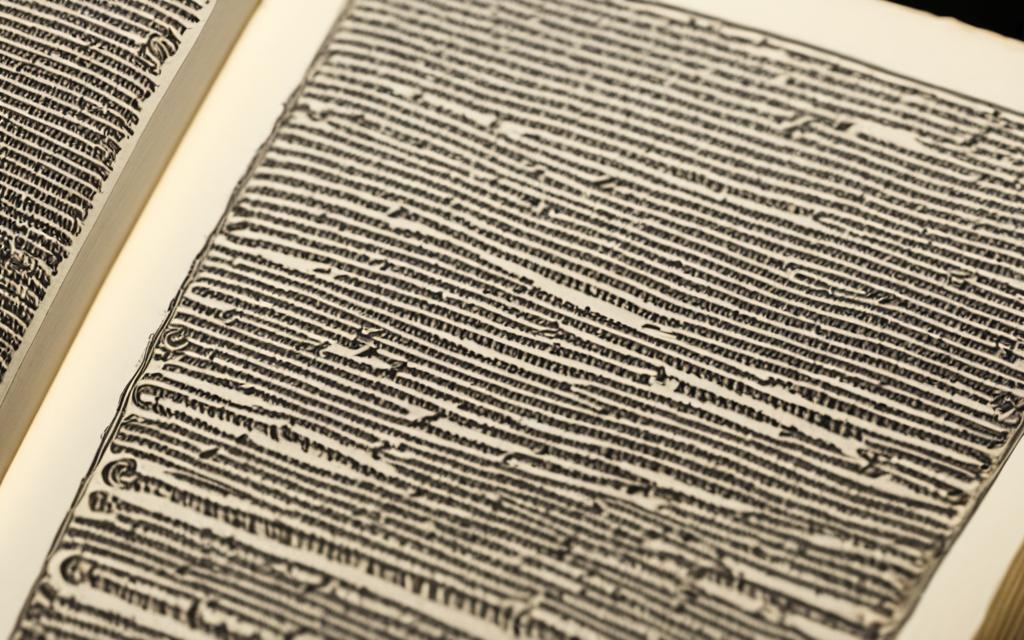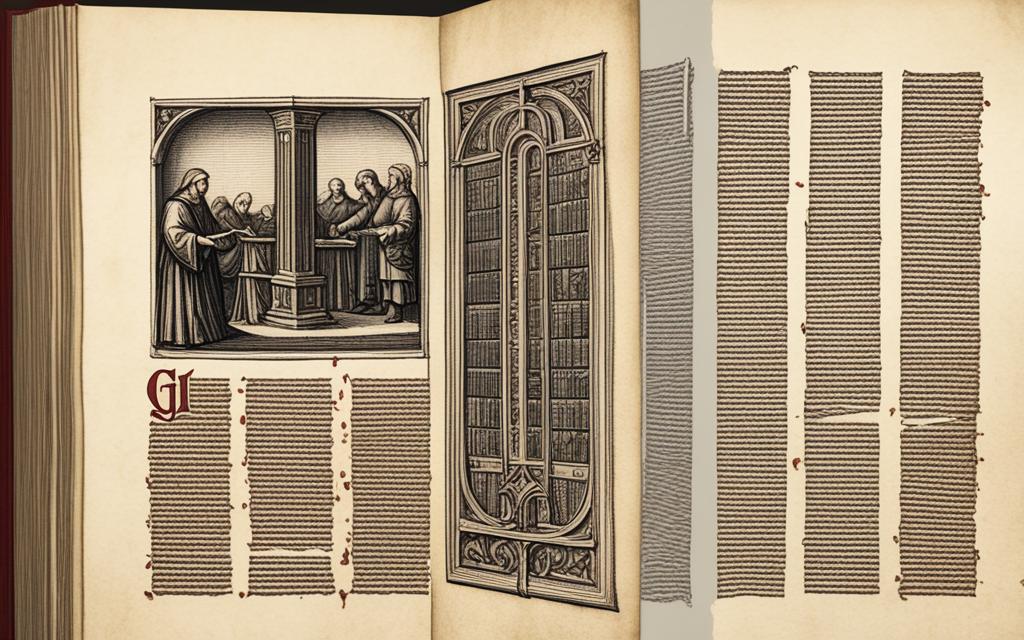The Gutenberg Bible is a key part of book history. It was printed by Johannes Gutenberg between 1452 and 1455. At that time, in Mainz, Germany, it was the first major book printed in the West using movable metal type.
This Bible, also known as the 42-line Bible, changed how we think about books. Johannes Gutenberg’s invention made books more affordable and available, helping spread knowledge. The Gutenberg Bible stands not just as a technical marvel but as a symbol for learning and sharing information widely.
Exploring this Bible’s history is truly inspiring. Its printing influenced the Renaissance and set the stage for how we share information today. The Bible not only showcases great craftsmanship but also marked a turning point for Western culture.
Key Takeaways
- The Gutenberg Bible was the first major book printed in the West using movable metal type, a revolutionary printing technology invented by Johannes Gutenberg.
- Gutenberg’s invention dramatically reduced the cost and time required for book production, making knowledge more accessible to the masses.
- The Gutenberg Bible catalyzed the Renaissance and ushered in a new era of knowledge dissemination.
- Despite the passage of centuries, a small number of Gutenberg Bibles have survived, with most held in institutional collections.
- The Gutenberg Bible’s physical characteristics and printing process showcase the remarkable craftsmanship of its creators.
The Gutenberg Bible: A Printing Revolution
The Gutenberg Bible marks a huge change in history. Johannes Gutenberg came up with the printing press with movable metal type. Before this, books were all written by hand, which made them very costly and only the rich could buy them. Gutenberg’s machine made it possible to print lots of books at once. This made books cheaper and more people could get them.
Johannes Gutenberg’s Groundbreaking Invention
Johannes Gutenberg was a goldsmith. He shook things up in the book printing world with his press. His use of movable metal type was new. It meant books could be made quickly and easily, unlike the slow, hand-copied books of the past.
The Birth of Movable Type Printing
Gutenberg’s printing press was a game-changer. It used movable metal type. This was a turning point in book printing. Thanks to this, The Gutenberg Bible became the first big book printed in the West that way. This new system meant more people could buy books because they cost less.
Impact on the Renaissance and Beyond
The Gutenberg Bible and his press changed everything. People could now afford books. This new way of printing helped spread ideas and learning. It’s a big part of what made the Renaissance a special time in history.
Unraveling the Gutenberg Bible
The Gutenberg Bible was printed before 1501, making it an incunabulum. It shows off early book printing technology. Looking at its physical qualities, we see great detail and expert work in every part.
Physical Characteristics and Features
The Gutenberg Bible is a huge book. It’s about 15 inches tall and 10 inches wide. It comes with a sturdy leather cover that’s covered in beautiful designs. The pages, made from vellum, have an off-white color. This makes the words clear and easy to read.
Every page is carefully designed. There are two columns of text, and each space has big margins. This makes it look nice and simple to read. The writing is in a Gothic script called Textura, a common style in the Middle Ages. The first letters of new chapters are especially decorative. They show the talent of the book’s artists.
Printing Process and Materials
Gutenberg used a special way to print the Bible. He used metal letters that could be moved around. This made it possible to print many copies quickly, unlike writing everything by hand. Making the Gutenberg Bible required a lot of steps. Each metal letter was cast by hand. Then, the pages were carefully set and printed on the vellum.
The makers used only the best stuff to create the Gutenberg Bible. The type was made of a strong mix of lead, tin, and antimony. This type could be used over and over, lasting a long time. The ink was also premium. It was an oil-based ink that gave a deep black color. This helped the text stay clear and dark for ages.

The Gutenberg Bible: Historical Significance
The Gutenberg Bible is more than just a book; it changed history. It made knowledge available to more people, starting the process of sharing information with everyone. Before the printing press, books were expensive and written by hand, so only the wealthy could afford them. The Gutenberg Bible changed this by making books cheaper and easier to produce, spreading knowledge throughout Europe.
Democratization of Knowledge
The Bible’s print changed how people learned and shared ideas. Because it was more affordable and widely available, many more folks got to read and learn. This shift influenced education and religious thinking, leading to more personal engagement with the Bible rather than relying only on what the Church said. This helped spark the Protestant Reformation.
Influence on Religion and Education
The Gutenberg Bible also transformed religious and educational systems. It did this by being more widely accessible, changing how people saw and understood religious teachings. In doing so, it lessened the Church’s control over religious information. This was a huge step towards individual religious thought.
It also greatly impacted education. With more books available, more people learned to read. This spread of knowledge was a key factor in advancing education for all. It prepared the way for more accessible learning and increased human knowledge.

Surviving Copies and Locations
A small number of The Gutenberg Bible have lasted for centuries. Only 49 complete or nearly complete copies are left worldwide. Most are kept in libraries and museums.
Across the world, these valuable copies are found. The United States is home to some. For example, the Library of Congress in Washington, D.C. owns a well-preserved copy.
The Morgan Library & Museum in New York City and the Huntington Library in California have their own versions too. In Europe, The Gutenberg Bible is found in key places. This includes the British Library in London and the Bibliothèque Nationale de France in Paris. It is also in the Royal Library in The Hague, Netherlands.
These copies show the start of the printing revolution. They are highly valued by both scholars and book lovers everywhere.




